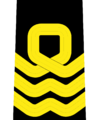Australian Navy Cadets
This article has multiple issues. Please help improve it or discuss these issues on the talk page. (Learn how and when to remove these messages)
|
| Australian Navy Cadets | |
|---|---|
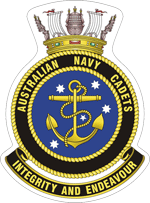 | |
| Active | 1907 – present |
| Country | |
| Role | Volunteer youth organisation |
| Size | 81 units 2,350 cadets |
| Part of | Australian Defence Force Cadets |
| Headquarters | Directorate ANC, Brindabella Business Park, Canberra |
| Motto(s) | Integrity and Endeavour |
| Anniversaries | 1 July |
| Website | https://www.navycadets.gov.au/ |
| Commanders | |
| Chief of Navy | VADM Mark Hammond RAN |
| Director General ANC | CDRE David Greaves RAN |
| Director ANC | CMDR Mark Cohayney RAN |
| National Commander ANC | CAPT Peter Alderson ANC |
| Insignia | |
| Australian Navy Cadets Ensign (2001–present) | 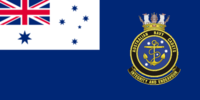 |
| Naval Reserve Cadets Ensign (1973–2001) | 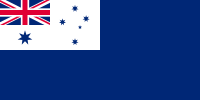 |
| Australian Sea Cadet Corps Ensign (1956–1973) |  |
| Naval Ensign (Still considered as the British navy flag going all the way back to the Napoleonic wars (1907–1956) | 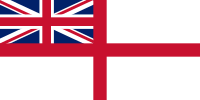 |
The Australian Navy Cadets (ANC) is a youth development organisation supported by the Royal Australian Navy, with a focus on the maritime domain. The organisation promotes activities, both on land and in water, with the key objectives of building self-confidence and developing teamwork and leadership skills.[1]
The program, which comprises 81 training ships and about 2,350 cadets nationwide, is available to all young Australians between the ages of 13 and 18.[1]
Together with the Australian Air Force Cadets and Australian Army Cadets, it forms the Australian Defence Force Cadets.
History
[edit]Established in the early 1900s, the organization received official recognition in 1910 with the passing of the Naval Defense Act. Before 1973, the Royal Australian Navy and the Navy League of Australia shared administrative duties for the group, which was then known as the Australian Sea Cadet Corps.
The organisation was renamed the Naval Reserve Cadets after the Navy assumed full control of it in 1973. In 2000, Australian Navy Cadets was the final name change that was suggested by the Australian Government review. "Cadets The Future."[2]
Boys Naval Brigades (Victoria), 1901–1911
[edit]
The Boys Naval Brigades were the earliest youth naval organisation in Australia. This organisation was run in conjunction with the Church of England. In 1901, Chief Gunner Robert Kearns of the Victorian Navy pioneered the Boys Naval Brigade movement, forming the first group near Swan Island, Port Phillip. Soon after, in 1903, the second group was formed in Ballarat.[3] The Boys Naval Brigade disbanded in 1911, when the government issued compulsory training from July 1, 1911. Resulting in its members joining the Defence run Australian Naval Cadet Corps.
Australian Naval Cadet Corps, 1907–1950
[edit]March 1907 saw the recruitment for the Australian Navy's 'Australian Naval Cadet Corps', which begun activities in July of 1907. The ANC Corps had been active up until 1911 when the Government's Compulsory Training legislation transferred them into the newly created RANR(M) Militia where they continued training throughout the First World War. After the war, the ANC Corps was re-established, and later on in 1929 compulsory training of the ANC Corps had ceased. Once again in 1939, with the breakout of the Second World War, the ANC Corps deferred training as all Naval personnel were needed in the fight. The organisation resumed its efforts after the war.[3]
Navy League Sea Cadet Corps NLSCC, 1920–1950
[edit]In 1920, a second private Sea Cadet body was formed following the formation of the third Navy League Branch in New South Wales. This NSW Branch, established the Navy League Sea Cadet Corps for young boys. The NLSCC operated in parallel with the ANC Corps which was recently re-established after the war. During the 1920s, the NLSCC expanded rapidly. Other states gradually formed Navy League branches along with their own Navy League Sea Cadet units.

Unlike the ANC Corps who had halted operations during the Second World War, the private NLSCC remained operational but was reduced in units as many volunteer trainers had enlisted to serve in the war. The Royal Australian Navy recognised this effort and gave praise to the NLSCC, who up until now operated with no assistance from the Navy. Negotiations commenced with the Navy League regarding future support, but because the Australian Navy League was a branch of the United Kingdom's Navy League, this was not possible. To facilitate this problem, all Australian Branches joined to form the Australian Body, the Navy League of Australia, and it renamed its cadets the Australian Sea Cadet Corps.[3]
RANR Cadets, 1950–1973
[edit]The RANR Cadets was an organisation which ran alongside the Australian Sea Cadet Corps. The program was considerably smaller in size compared to its counterpart, with roughly 300 cadets.
Australian Sea Cadet Corps ASCC, 1950–1973
[edit]The Australian Sea Cadet Corps, now with support from the Navy, expanded rapidly under the leadership of its volunteer ex-service trainers. By 1970 the organisation reached 2,500 cadets. The Royal Australian Navy expressed concerns about the increasing number of cadets and the cost that would come along with maintaining them. This concern was complied with by the ASCC, and by late 1972 the group had 2,000 members.
Representatives from the Navy League and the RAN talked about their shared concerns in 1972 on the rising costs of managing and sustaining the ASCC program. In the end, the RAN and Navy League decided that the Navy would be solely in charge of training the 2000 strong ASCC and 300 strong ANC. Under new Defence law, the ANC and the ASCC cadets united into the newly formed Naval Reserve Cadets (NRC). The Navy League was given time to restructure its ASCC in the event that the Navy decided to stop training cadets, per an agreement with the Australian Commonwealth Naval Board (ACNB). The ASCC members of the Navy League were transferred into the new Naval Reserve Cadets (NRC) of the RAN in January 1973.[3]
Naval Reserve Cadets NRC, 1973–2000
[edit]Problems sprouted early in the newly conjoined Naval Reserve Cadets, when the 21st Prime Minister of Australia, Gough Whitlam cancelled all cadet activities and withdrew ADF support for cadets in 1975.[4] The Navy League's agreement with the Australian Commonwealth Naval Board was honoured by the government who informed the Navy League and gave time for the reorganisation of the ASCC structure. The end of 1975 saw the Whitlam government voted out, and Malcolm Fraser elected the 22nd Prime Minister of Australia. The cadet situation was reviewed, and the Fraser government reinstated cadet training. In 2002, the name was changed back to Australian Naval Cadets, the original name of the 1907 “Australian Navy Cadet” Corps.
Aims
[edit]Mission
[edit]The Australian Navy Cadets provide nautical training that involves primarily water-based activities. Navigation, communications, first aid, drill, maritime history, and firearms proficiency are among the skills taught. With its program, the ANC hopes to offer the following:[5]
- develop an interest in the Navy and its tradition,
- encourage cadets to continue military or community service,
- give cadets a foundation of military knowledge and discipline,
- develop the qualities of leadership, self-discipline, self-reliance and initiative, and
- provide training that may later assist in achieving competencies required during Navy induction training.
Purpose
[edit]Australian Navy Cadets is a youth personal development program conducted by the Australian Navy in collaboration with the community. Its goal is to develop the individual, the community, and the Australian Navy in order to benefit the nation.[5]
Values
[edit]
The Australian Navy Cadets adopts the values of the Australian Navy - Service, Courage, Respect, Integrity and Excellence - to empower youth to achieve their potential.[5]
Structure
[edit]The organisational structure of the ANC is based on three hierarchical levels: national, flotilla, and training ship.
The country is split into regions, the regions have flotillas, which have several training ship units. Inside of the training ships is Staff and Cadets, who take on positions to run the training ship accordingly every parade night or weekend camp.
National
[edit]Director General Australian Navy Cadets
[edit]The position of Director General Australian Navy Cadets (DGANC) is responsible to CN, through the Deputy Chief of Navy (DCN), and to CJC, through the Head of Joint Services Support Division, for the following responsibilities:
- delivery of a strategically based, productive and cohesive ANC program designed to enhance the cadet experience and encourage greater youth participation in the ANC
- provision of specialist advice to the RAN and JSSD on matters relating to ANC organisational structures, policy, governance, personnel, administrative procedures, training of personnel, safety management and oversight of ANC resources
- liaison with the Defence organisation and other external agencies.
- ensuring ANC policies, procedures and practices align with the DYSF
- conducting annual reviews of youth facing positions and WWCC positions within DGANC and provide any updates to DNWM for annotation in PMKeyS.
- DGANC chairs the ANC Senior Leadership Group (ANCSLG) and the ANC CadetSafe Board.
The current DGANC (as of July 2024) is CDRE David Greaves, RAN.
Director Australian Navy Cadets
[edit]The position of Director Australian Navy Cadets (DANC) is responsible for the day-to-day management of the ANC Directorate including the management of all RAN and Australian Public Service staff allocated to the ANC Directorate.
DANC through DGANC is responsible for:
- provision of timely advice to the RAN and Government on ANC issues of representation, policy, resources, safety, and reputation management
- management and governance of Commonwealth financial resources allocated for ANC support IAW the Public Governance, Performance and Accountability Act 2013 (PGPA Act)
- command liaison with Defence and other external agencies
- ANC policy coordination and promulgation.
The current DANC (as of July 2024) is CMDR Mark Cohayney, RAN.
National Commander Australian Navy Cadets
[edit]The position of National Commander Australian Navy Cadets (NCANC) is responsible through the DGANC, to CN and HJSSD for the following:
- the safe and effective delivery of the ANC youth program IAW the guidance provided by the DYSF and supporting documentation
- for the management of international relationships between the ANC and members of the International Sea Cadets Association (ISCA)
- for the recruitment, effective leadership and management of ANC members in accordance CN direction and the supporting guidance provided within YOUTHPOLMAN Parts 1 and 2, the YOUTH HQ website and this publication
The current NCANC (as of July 2024) is CAPT Peter Alderson, ANC.
Flotilla
[edit]Flotillas are groups of training ships (TS), each commanded by a Flotilla Commander (FLOTCOM), and supported by a small flotilla HQ staff of Unit Support Officers (USO). Flotillas draw support from the Functional Directorate staff within National ANC HQ and Director Flotillas (DFLOT) personnel.
The current flotillas and their Flotilla Commanders (as of July 2024) are:
| Flotilla Name | Flotilla Commander | Motto |
|---|---|---|
| Attack Flotilla | LCDR Lara Rice, ANC | "Force in the North" |
| Daring Flotilla | LCDR Chris Moyle, ANC | "We Stand As One" |
| Kellatie Flotilla | LCDR Bill Mckay, ANC | "To Serve" |
| Lonsdale Flotilla | CMDR Lisa Foley, ANC | "Wisdom Is Strength" |
| Moreton Flotilla | LCDR AJ Hughes, ANC | "Strong And Steady" |
| Taipan Flotilla | LCDR Matt Neville, ANC | "Swift And Sure" |
| Torrens Flotilla | LCDR Pieter Scott, ANC | "Faith And Fortitude" |
| Waratah Flotilla | LCDR Connor Boesel, ANC | "Advance Together" |
| Westralia Flotilla | CMDR Spike Jones, ANC | "Faithful And Bold" |
| Gallipoli Flotilla | LCDR Max Condon, ANC | "The Fighting Spirit" |
Training ship
[edit]Training ships operate throughout many locations in Australia, and are attached to a flotilla among other TS units. Each TS is commanded by a Commanding Officer (CO) who holds the rank of LEUT. The CO is often supported by an Executive Officer (XO) who holds the rank of SBLT. Some training ships also have Training Officers (TO) and a Whole Ship's Coordinator (WSC). The number of adult members and cadets can vary considerably, dependent on local circumstances.
Most training ships have a division(s). A division is a group of cadets, normally led by a senior cadet such as a CDTPO or CDTCPO. The ANC division system:
- provides constructive ANC (Australian Navy Cadets) guidance toward career progression
- facilitates effective two-way communication between all levels of the ANC
- promotes teamwork and positive morale
- supports and assists individuals to resolve intra-unit and interpersonal problems
The current training ships (as of July 2024) are:
| Unit name | Unit motto |
|---|---|
| TS Carpentaria | "Can Do Will Do" |
| TS Coral Sea | "Second To None" |
| TS Endeavour | "Search And Learn" |
| TS Pioneer | "Prepare The Way" |
| TS Rockhampton | "Ever Onward" |
| Unit name | Unit motto |
|---|---|
| TS Bundaberg | "Push The Boundaries" |
| TS Centaur | "Swiftly Fierce" |
| TS Gympie | "Toil Hard" |
| TS Gladstone | "Strive For A Better Future" |
| TS Koopa | "Never Waver" |
| TS Krait | "With Skill And Courage" |
| TS Maryborough | "Work In Unison" |
| TS Onslow | "Seeking Knowledge" |
| Unit name | Unit motto |
|---|---|
| TS Argonaut | "Ready To Dare" |
| TS Derwent | "Swift And Strong" |
| TS Emu | "Training To Lead" |
| TS Hobart | "Grow With Strength" |
| TS Mersey | "Fight On" |
| TS Tamar | "Fearless And Ferocious" |
| TS York | "Good Hope" |
| Unit name | Unit motto |
|---|---|
| TS Albury | "Avail Achieve Advance" |
| TS Barwon | "No Victory Without Honour" |
| TS Bataan | "With Talons And Beak" |
| TS Bendigo | "Advance With Purpose" |
| TS Henty | "With Pride We Serve" |
| TS Latrobe | "Bear And Forebear" |
| TS Melbourne | "Vires Acquirit Eundo" |
| TS Mildura | "Look Ahead" |
| TS Tingira | "Learn And Excel" |
| TS Voyager | "Where Destiny Calls" |
| Unit name | Unit motto |
|---|---|
| TS Brisbane | "Aim At Higher Things" |
| TS Diamantina | "Protecting The Future" |
| TS Gayundah | "Knowledge Is Strength" |
| TS Magnus | "Alis Aquilae" |
| TS Moreton Bay | "Willing To Try" |
| TS Norfolk | "Lead By Example" |
| TS Paluma | "Search And Serve" |
| TS Vengeance | "Perceive To Achieve" |
| Unit name | Unit motto |
|---|---|
| TS Armidale | "Stand Firm" |
| TS Culgoa | "Forward Without Fear" |
| TS Hawkesbury | "Quality Not Servitude" |
| TS Lismore | "Vigour Is Life" |
| TS Manoora | "Against All Odds" |
| TS Rushcutter | "Effort Reaps Reward" |
| TS Shropshire | "Strive And Flourish" |
| TS Tobruk | "Faithful And Strong" |
| TS Vendetta | "Knowledge Is Strength" |
| Unit name | Unit motto |
|---|---|
| TS Adelaide | "Training For The Future" |
| TS Augusta | "Proudly Sailing Forward" |
| TS Darwin | "Succeed With Pride" |
| TS Flinders | "Investigate And Explore" |
| TS Noarlunga | "No Risk No Win" |
| TS Stuart | "Always Prepared" |
| TS Whyalla | "Sail Ahead" |
| Unit name | Unit motto |
|---|---|
| TS Albatross | "Watch Me Soar" |
| TS Australia | "Endeavour" |
| TS Canberra | "For King And Country" |
| TS Jervis Bay | "Strive Valiantly" |
| TS Kanimbla | "Toil Hard" |
| TS Nepean | "Anchored In Success" |
| TS Orion | "Orbe Circumcincto" |
| TS Shoalhaven | "Follow Heavens Light" |
| TS Sirius | "Heavens Light Our Guide" |
| TS Supply | "Strengthen The Shield" |
| TS Sydney | "Thorough And Ready" |
| Unit name | Unit motto |
|---|---|
| TS Anzac | "Second To None" |
| TS Broome | "Knowledge Is The Pearl" |
| TS Bunbury | "Nothing Without Toil" |
| TS Canning | "Above All Service" |
| TS Comet | "Seek Excellence" |
| TS Kybra | "As One" |
| TS Mandurah | "Unity Is Strength" |
| TS Marmion | "Guided By Strength" |
| TS Morrow | "Always Ready" |
| TS Perth | "Learn And Flourish" |
| TS Vancouver | "Excellence By Effort" |
| Unit name | Unit motto |
|---|---|
| TS Ipswich | "Dare To Defy" |
| TS Kookaburra | "Alert" |
| TS Oxley | "Steadfast And Strong" |
| TS Southport | "Leading Through Service" |
| TS Toowoomba | "Fearless" |
| TS Tyalgum | "Unity Harmony Strength" |
| TS Vampire | "Let Us Be Daring" |
| TS Walrus | "Ever Onward And Upward" |
Activities and training
[edit]The framework that guides the cadet development program is called the Cadet Youth Development Continuum. The program aims to give cadets the chance to grow important personal qualities, life skills like resilience and teamwork, confidence, loyalty, and respect, and a sense of service to others.
Category Program
[edit]The ANC offers three categories which are aligned with the RAN and its many roles. These categories are Maritime Engineering, Maritime Operations, and Maritime Support. Cadets who reach the rank of Able Seaman are expected to have completed one of these categories. Category badges are awarded on completion of the category's workbook.
Maritime Engineering
[edit]The Maritime Engineering category develops a cadet in the basic principles of engineering in the maritime environment. A cadet will gain an appreciation of the mechanical and electrical systems used in watercraft and in larger maritime vessels.
Maritime Operations
[edit]The Maritime Operations category develops a cadet with an interest and ability in seamanship and general mariner skills.
Maritime Support
[edit]The Maritime Support category develops a cadet with an interest in support functions, including medical, catering, hospitality, supply chain, stores and administration functions.
Elective Program
[edit]Electives are optional courses that give cadets the chance to specialize in one or more areas of interest and advance their present level of ability. A cadet will typically select an elective that piques their interest or is in line with the ANC category they have selected.
The electives offered in the ANC consist of:
- Cooking
- First Aid
- Musician
- Physical Fitness and Well-being
- Powerboating
- Sailing
- Skill at Arms
- Bridge Operations
- Drone flying
- Robotics
Cadets of all ranks are given the option to choose as many of these courses as they wish. On completion, elective badges are awarded. Elective badges have three levels: Bronze, Silver and Gold.
These elective badges are velcroed onto a black brassard worn on the DPNU. Cadets can sew on a maximum of three badges onto the cuff of their right arm for the ceremonial uniform (S3/W3).
Promotion
[edit]Every ANC rank has a workbook that provides the cadet with the knowledge and abilities required to advance to the next rank.
A cadet must go through a Promotion Board, which is led by flotilla staff, when they have attained the rank of Cadet Leading Seaman and wish to be promoted. The cadet's leadership qualities and situational response will be evaluated. In order to advance to Cadet Warrant Officer, you must also complete a promotion board.
Australian Navy Cadets are members of the ISCA and have the chance participate in the ANC International exchange program.
The program happens multiple times a year, and cadets are able to experience similar organisations in other select countries:
The main goals of the Cadet exchanges are to spread friendships, kindness, pleasure, cultural experiences, and knowledge about new places and the operations of other Cadet organisations.

Every Cadet traveling on an exchange is escorted by an adult staff members.
National activities are fully funded by Defence who arrange the activities, land and air travel, accommodation and food.
Annual National Camp
[edit]Cadets are given the opportunity to attend a week-long National Camp at a RAN Shore Establishment such as HMAS Cerberus.
Activities that may be included on a national camp are:
- Visit a Navy warship or submarine
- Fire-fighting and smoke walk
- Target shooting
- Survival at Sea
- Leadership & teamwork challenges
- Rock wall climbing
- Navy helicopter flights
- Drone flying
- Power boating
- Sail training
- Defence careers presentation
Annual National Competitions
[edit]A national regatta and shooting competition is hosted every year for cadets across Australia. The teams from each Cadet Unit compete in these events to test their abilities and training. These tournaments evaluate the abilities and activities that the Navy Cadets learn during the year.
Flotilla and unit activities
[edit]Flotilla and unit-based activities are among the more basic and frequent events in the Australian Navy Cadet program. Flotillas can offer a variety of events for cadets in any of the training ships situated in their flotilla. Training ships are also able to host their own activities solely for cadets inside their unit. A training ship will always host a 'Parade Night' once a week on a select day. The schedule of a parade night can vary from TS to TS, but will normally have a Colours Ceremony (raising of the flag), Drill Training, Lessons, Action Based Learning (ABLs), Stand Easy (a time to eat) and a Sunset Ceremony (lowering of the flag).
The Australian Navy Cadets teaches the skills required to operate small powerboats safely including weather awareness, basic navigation, and seamanship knowledge.
Several opportunities and experiences related to sailing are offered by the Australian Navy Cadets. Cadets can learn to sail at their unit, take part in sailing weekends at one of the Maritime Training Centers, operate a dinghy, and compete against other cadets in regattas.
The Australian Navy Cadets is an authorized Discover Sailing Center under the Australian Sailing Organization.
The ANC offers a comprehensive firearms safety training program using .22 calibre rifles (Bruno CZ452). Cadets learn how to handle a rifle safely before participating in a 'live fire' at a rifle range.
Ranks and uniforms
[edit]The uniforms of the Australian Navy Cadets are based on that of the Royal Australian Navy (RAN), with only a few differences between the two. Unlike the RAN, the ANC's shoulder flashes and SRIs (Soft Rank Insignia) read "AUSTRALIAN NAVY CADETS" in replace of the RAN's "AUSTRALIA". Another significant difference is between the officer insignia. Staff of the ANC display wavy laces while RAN officers have straight laces. This difference originates from the Royal Australian Naval Volunteer Reserve. CDTPOs and above are not authorised to wear the Senior Sailor style of uniform that the Royal Australian Navy possesses for various reasons, instead conforming to the Junior Sailor's uniform.
Uniforms
[edit]Staff
[edit]| Uniform Number | Photo | Occasion |
|---|---|---|
| S3 | Formal events such as Anzac Day
(Summer dress) | |
| W3 | Formal events such as Anzac Day
(Winter dress) | |
| W6 | Semi formal events in winter | |
| S7 | Semi formal events in summer | |
| W12 | Working rig in winter | |
| S12 | Working rig in summer |
Cadets
[edit]| Uniform Number | Photo | Occasion |
|---|---|---|
| S3 | Formal events such as Anzac Day
(Summer dress) | |
| W3 | Formal events such as Anzac Day
(Winter dress) | |
| W6 | Semi formal events in winter | |
| S7 | Semi formal events in summer | |
| W12 | Working rig in winter | |
| S12 | Working rig in summer |
Ranks
[edit]Example of use; LCDR Robert Rooney, ANC
Example of use; CDTPO Robert Rooney
Volunteer helpers
[edit]A Defence Approved Helper (DAH) is a volunteer who isn't a part of the Australian Navy Cadets or the Australian Defence Force.
Example of use: Mr Robert Rooney, DAH
Speciality insignia
[edit]Category badges
[edit]| Maritime Engineering | Maritime Operations | Maritime Support |
|---|---|---|

|

|

|
Elective badges
[edit]| Cooking | First Aid | Musician | Physical Fitness | Powerboating | Sailing | Skill at Arms | Bridge Operations | Drone Flying | Robotics |
|---|---|---|---|---|---|---|---|---|---|

|

|

|

|

|

|

|

|

|
Awards
[edit]| Award | Staff | Cadet | Years Service | Notes |
|---|---|---|---|---|
| Personal Efficiency Badge | All Ranks | All Ranks (except RCT) | Completion of set qualification criteria
personal readiness with 12 month renewal |
Staff (Silver Badges with Gold Wheel)
Cadet (Silver Badge with Silver Wheel) |
| ACT Completion Certificate | N/A | All Ranks eligible | Completion of an ACT specialisation | Differs per flotilla |
| Long Service & Good Conduct Stripe | N/A | All Ranks (except WO & MIDN) | Staff
(1 for every 4 years of Service) (1 for 4 years service as a cadet) (1 for every 4 years service in the RAN or RANR) (maximum of 3 stripes) Cadet (1 stripe for every year of service) (maximum of 3 stripes) |
|
| 5 Year Service Certificate | All Ranks | N/A | completion of 5 years service | |
| 10 Year Service Certificate | All Ranks | N/A | completion of 10 years service | |
| Australian Cadet Forces Service Medal | All Ranks | N/A | For 15 Years Long Service | A clasp is awarded for every five years thereafter. |
| National Commander ANC Commendation | All Ranks | N/A | for meritorious service | In Gold, Silver and Bronze. |
| Director General ANC Commendation | All Ranks | N/A | for extraordinary meritorious service | In Gold, Silver and Bronze. |
| Conspicuous Service Medal (CSM) | All Ranks | N/A | The medal recognises commendable achievement or commitment to duty in a non-combative context. It is awarded to members of the Australian Defence Force and certain other people for example, Defence Force chaplains. | |
| Conspicuous Service Cross (CSC) | All Ranks | N/A | The cross recognises exceptional dedication to duty or outstanding achievement in skills or judgement in a non-combative context. It is awarded to members of the Australian Defence Force and certain other people such as members of philanthropic organisations. |
See also
[edit]- Cadets (youth program)
- Australian Defence Force Cadets
- Australian Air Force Cadets
- Australian Army Cadets
- Other Sea cadet organisation
References
[edit]- ^ a b "Who we are". Australian Navy Cadets. Retrieved 4 July 2024.
- ^ "History". Australian Navy Cadets. Retrieved 4 July 2024.
- ^ a b c d "Naval History" (PDF). The Navy League of Australia - Victoria Division. July 2017. pp. 14–17. Retrieved 4 July 2024.
- ^ "Historic reforms prepare cadets for the future". Parliament of Australia. Retrieved 4 July 2024.
- ^ a b c "Vision, purpose and values". Australian Navy Cadets. Retrieved 4 July 2024.
- ^ CDRE Greaves, David (1 July 2024). Attack Flotilla Establishment Directive.
- ^ CDRE Greaves, David (1 July 2024). Daring Flotilla Establishment Directive.
- ^ CDRE Greaves, David (1 July 2024). Kellatie Flotilla Establishment Directive.
- ^ CDRE Greaves, David (1 July 2024). Lonsdale Flotilla Establishment Directive.
- ^ CDRE Greaves, David (1 July 2024). Moreton Flotilla Establishment Directive.
- ^ CDRE Greaves, David (1 July 2024). Taipan Flotilla Establishment Directive.
- ^ CDRE Greaves, David (1 July 2024). Torrens Flotilla Establishment Directive.
- ^ CDRE Greaves, David (1 July 2024). Warratah Flotilla Establishment Directive.
- ^ CDRE Greaves, David (1 July 2024). Westralia Flotilla Establishment Directive.
- ^ CDRE Greaves, David (1 July 2024). Gallipoli Flotilla Establishment Directive.
- ^ CADET YOUTH DEVELOPMENT CONTINUUM (CYDC) FRAMEWORK. Australian Navy Cadets. August 2023.
- ^ "International exchange program". Australian Navy Cadets. Retrieved 5 July 2024.
- ^ "National Activities". Australian Navy Cadets. Retrieved 5 July 2024.
- ^ "Powerboating". Australian Navy Cadets. Retrieved 5 July 2024.
- ^ "Sailing". Australian Navy Cadets. Retrieved 5 July 2024.
- ^ "Firearms training". Australian Navy Cadets. Retrieved 5 July 2024.
- ^ ANP3700 (2nd ed.). Australian Navy Cadets. October 2020. p. 7.57.
- ^ ANP3700 (2nd ed.). Australian Navy Cadets. October 2020. p. 8.16.


